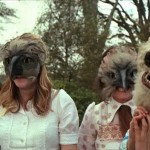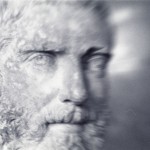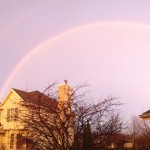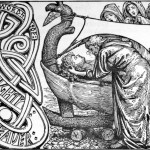When I first started this blog, I began with the name Temple of the Earth Mother, a name which was simultaneously pretentious and boring. I mean, you can’t really get more generic in Pagan terms than “Temple of the Earth Mother”. But I actually had a good reason for the name that I never got around to explaining.
When I started blogging, it marked a new phase in my spiritual journey, a re-dedication to developing a personal Pagan practice. I’m good at talking and writing about Paganism, but not so much the actual doing — which raises the question, “Who am I to be writing about Paganism if I don’t practice what I preach?” Part of the “doing” meant connecting more to my natural environment.
I was inspired in this regard as I read about a Neopagan group called TOTEG Tribe, which was created by Joseph Wilson. Wilson was interesting to me because his practice (1) eschewed esotericism, (2) focused on the natural environment where one lives, and (3) favored connecting to the gods as we experience them today (i.e., Father Sky, Mother Earth) rather than ancient deities from other cultures.
TOTEG Tribe was founded in 1977 and reconstituted in 1996. However, with the exception of an active circle in Utah, it is largely non-existent today. I was disappointed to learn this, as TOTEG seemed to embody the kind of Pagan practice I was looking for: the essence being connecting to nature through listening.
In his autobiography, “Warts and All”, Joseph Wilson describes his involvement in many different Neopagan groups, some of which he founded but later moved on from. Reading his story, I was impressed that he seemed to be searching for something that was never quite captured by any of the groups he was involved with. Near the end of his story, Wilson recounts a pivotal moment that I think captures the kernel of wisdom that he was looking for. He writes:
“1977 was a pivotal year in many ways. I met Ernie (Longwalker) Peters, a Lakota Medicine Man who helped people who came from the Indian reservations in search of a better life to survive in Los Angeles. Ernie was a veteran of the 1972 Wounded Knee occupation and one of the founders of Athe American Indian Movement. Although I had no desire to “play Indian” (and Longwalker would have refused to talk to me if I had) I was interested in any advice he could give me.
“His best advice was, ‘You know, Joe, if you or other white folks are really serious about our spirituality, you won’t go asking me, or us, or anyone else about what we believe, our ceremonies, our regalia, and stuff. Instead you will go out into the woods and talk to the sky, the earth, the rocks, the rivers, and the streams. And LISTEN to the answers, and listen to your ancestors. Only then will you start the long path to healing.’ I finally started to understand. …
“The next few years were difficult. Joanna and I now called the circle that met at our house the “Temple of the Elder Gods” (TOTEG). I talked Joanna into working with me to use TOTEG to experiment and find ways to do exactly what Longwalker, Sean and Siobhan, Roy, and Ruth. It wasn’t easy. It meant that we had to do things that others found to be upsetting, like intentionally avoiding culturally specific names of any kind, whether they be Greek, or Egyptian, or Irish, or Welsh, or Norse, or Caananite, and on the same hand intentionally avoiding the specific rituals that were a part of any of my Craft heritage. The challenge was to connect directly with our ancestors and the Gods and to discover ways that were appropriate to them based on where we lived.”
That is what I wanted (want) to do: listen — listen to the gods within me (in my psyche) and listen to the gods without me (in nature), and experiment with the ways to best connect with them.
I thought about trying to start a TOTEG circle, but I decided I should try doing this on my own first and was having difficulty connecting with the active members of TOTEG. Still I wanted a name for my practice. In looking for a name, I came across a name that Wilson had actually considered and rejected: “TOTEM: Temple of the Earth Mother.” He writes:
“The name ‘Toteg’ started back in about 1976 or 1977 as the lazy way people called the group we had in Sunland, California. It began life as an acronym for “Temple Of The Elder Gods” (T.O.T.E.G.). I deliberately avoided calling the group ‘Temple Of The Earth Mother’ (TOTEM) because even though I thought it was cute, I didn’t want people calling us that and say we were playing Indian or something. TOTEG was a forerunner of Toteg Tribe.”
In spite of Wilson’s insistence that TOTEG avoid borrowing from other cultures, it seems to me TOTEG still has a certain Native American flavor. This is probably because Wilson was strongly influenced by Native Americans, including Ernie Longwalker, mentioned above. He was also influenced by Michael Harner’s so-called Core Shamanism on Wilson, which also has a Native American flavor.
In any case, I decided to call my spiritual practice TOTEM: Temple of the Earth Mother. Unlike Wilson, I didn’t feel the name was any more Native American than other aspects of the Neo-Shamanistic TOTEG Tribe. And I felt that the name paid homage to Wilson and TOTEG.
Incidentally, a “totem” is a spiritual ancestor of a clan or tribe, especially non-human spiritual ancestors. The name originates with the Ojibwe Native North American tribe, but totemic beliefs are present throughout the world. The notion to totem or spirit animals has also been adopted by the New Age, Neopagan, and Mythopoetic Men’s movements. But the word has been misapplied to so-called “totem poles”, which are really heraldric and not totemic.
In her book Themis, Jane Ellen Harrison, contrasts the Greek worship of chthonian daimones, who die and are resurrected, with the worship of the immortal Olyumpians. In my opinion, the contrast between daimonic and Olympian worship is mirrored in the contrast between contemporary Neopagan and Christian worship. What is interesting for the present purposes is that Harrison describes the daimones as the spirit or “genius” of the tribe, in other words, a kind of totem. Since I identify contemporary Neopagan worship with Harrison’s daimonism, it makes sense to call my practice TOTEM.
In the process of deciding on a name, I Googled the name “Temple of the Earth Mother” and found a translation of the lyrics of an Incan song by Mike Oldfield:
Huaca Pacha Mama
Huaca Saqsaywaman
Huaca Yachaq runa
Huaca Munaq Runa
Translation:
Temple of the Earth Mother
Temple of the Speckled Hawk
Temple of the Wise One
Temple of the Loving One
The name “Pacha Mama” or “Pachamama” has been used as the title of many songs and is even the name of a band, and a further search led me to one song, which I particularly liked by Lily Frost:
Pacha Mama
From my center to Lake Huron
From Lake Huron to my memories
From my feet to the roots in the earth
From the roots to the depths of my soul
From my heart to the western wind
From the wind to the freedom within
Take my hand ‘cross the land n’which we stand
From the land to the sea we expand
(chorus)
Spread my wings like an eagle soars
High above the oceans and the stones
Drop of blood deep inside of me
From the wampum to my history
Drop of blood deep inside of me
From the wampum to my history
Pacha Mama, Pacha Mama
Pacha Mama, Pacha Mama
From my eyes to the skies
Through the skies I feel it swayin’ high
From sweet summer to the winter fierce
Through the winter with nomad’s will.
(chorus)
This song expresses a deep sense of connection between the human soul and the natural world. This is the essence of the spirituality that wanted to experience through the practice which I intended to call TOTEM: Temple of the Earth Mother. Although I changed the name of my blog, if I ever do start a “tradition”, I think will call it TOTEM: Temple of the Earth Mother, in honor Joseph Wilson.















